Triumph made an unusual prototype in 1964, dubbed the Fury. It was the only unibody car Triumph had built to that date. In a sense, Triumph created its own fork in the road: would it go down a new path, making unibody cars like its competitors? or would it continue to pursue the body-on-frame strategy? Four years later, when the company finally introduced a successor to the TR250, we found out: Triumph introduced the TR6 as a body-on-frame vehicle. A shortage of funds is responsible for the architecture of the TR6s that we appreciate today. Meanwhile, its lines – courtesy of Karmann in Germany – also deviated from its curvaceous brethren, being straight, almost severe. The new car was a hit with its six-cylinder engine and reasonable price. This 46k mile 1974 Triumph TR6 is located in Roseville, Michigan, and is listed here on the dealer’s site for $17,995. Thanks go to T.J. for the tip!
The engine is the 2.5-liter in-line six-cylinder that Triumph developed over decades from a smaller displacement version used in the Vanguard. In the US, this motor utilized two Zenith-Stromberg carburetors and produced 104 bhp, a major step down versus the European fuel-injected motor at 150 bhp (early cars). Fortunately, abundant options for upgrades exist, including Webers (ick) and even SUs or Mikuni’s. All that said, the original set-up did produce reasonable performance for the day: the TR6 could hustle from zero to sixty in 8.2 seconds, and a top speed of 120 mph is achievable. The engine bay is tidy and matches the Mimosa exterior, commensurate with the low mileage claim.
The interior shots in the listing are not as clear as they could be, but as best as I can tell it presents well. The dash is walnut veneer over plywood, and this one looks nice. The gear change is a four-speed manual; when new the cars were offered with optional overdrive. Hard to say if this one has overdrive or not.
Even the convertible top is in great condition, with clear windows and a decent fit. Hardtops are available for the TR6, which gives the car a whole new look. This example being a ’74 is burdened by ugly rubber overriders on what used to be delicate chrome bumpers. On the other hand, the overriders are better than the raised contraption that defaced the car in its last two years. Overall, it’s hard to find a fault with this car, with the proviso that the photos aren’t of the best quality. The price of these cars hasn’t really budged in five years; $20k is about what average examples trade for. If the mileage can be substantiated and this car is as nice as it appears, this could be, if not a bargain, at least a reasonable deal.





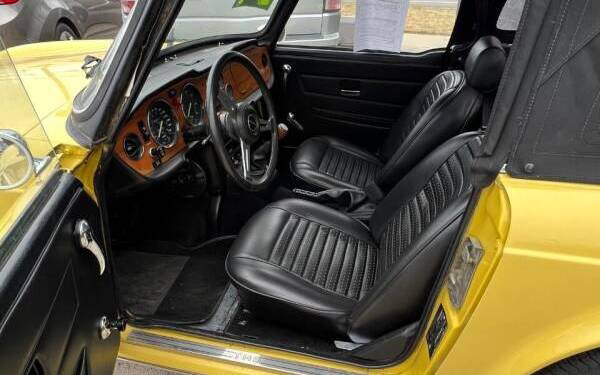

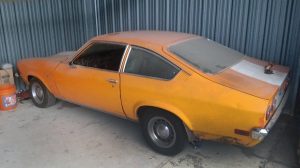
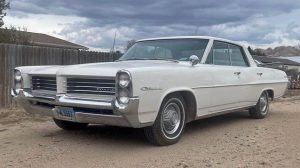
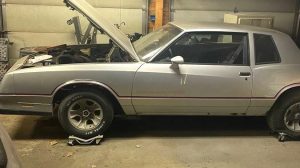
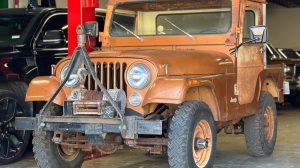


It’s a nice one, for sure. This particular car does not have O/D, there would be 2 stalks on the right side of the steering column, and no “Overdrive” badge below “Triumph” above the right tail light. I suppose, if one never had it, they might not miss it, but these motors make a resonance at about 3200 rpms, like all in line 6s. Cool for a while, but annoying, not unlike that Detroit diesel of yore. An O/D drops the Rs to around 2750, and out of that noisy range. The other thing, years ago, diesels had “motor miles” on the tach, like an odometer. It measured total engine RPMs and naturally, the lower the RPMs, the longer the motor would last,,theoretically. It’s just better, and well worth the pittance it cost when new, but was a tough sell for some reason. It’s comical, 5 speeds came out, that were basically the same thing, and were a hit. Go figure. Nice car, but the no O/D is a deal breaker, and the Webers naturally don’t do much. Looks finicky to me. These people screw around with this multiple carb stuff, why not just a good ol’ Yankee Holley 2 barrel? I don’t see anything like that for these. Make sure your AAA membership is current,,,like the Jeep, you never know.
“These people screw around with this multiple carb stuff, why not just a good ol’ Yankee Holley 2 barrel? I don’t see anything like that for these.”
It’s like this:
Not having the 90 degree bend for the flow from the downdraft..
Multiple carbs gives equal length runners more often and easier.
Many inline engines with sidedraft carbs do have aftermarket kits for single downdraft (dual for some 6s) WEBERS or your Holly. (caps oops) I don’t approve.
It’s not that hard to synchronize carburetors, even with no special tool.
Would you put a 4 bbl on a V12 to get rid of 3 or 6 Webers?
Always synchronized carbs in my ’63 MGB by listening to the sound of the air being sucked into each one using a length of heater hose and adjusting to make them sound the same.
Some ones in Australia with the PI motor had the overdrive switch in the top of the gear knob.
When did the overdrive move to the shifter knob? I recall the slide switch in the shifter knob in one of my 70s Triumphs.
Not on TR6’s – the O/D switch was a longer version
of the turn signal switch.
Had a customer with a ’72 that was smoged to death and needed some suspension upgrades. Replaced the distributor with a competition unit and modified the carbs to get full use out of them. Put adjustable tube shocks and different springs on all four corners and had a car that ran great and handled like it should have from the factory. These are nice cars if you tweak the right areas.
Mine didn’t have O/D,& I was happy with it,as well as
the stock Zenith-Stromberg carbs.Why does everyone seem
to that Webers are always the answer?
I’ve never cared for the luggage racks that are bolted to
the trunk lid.And,although it’s not the way ’74’s came,I’d paint
the center caps on the wheels Black,& install Redline tires,
which are available through Coker Tire.
To me,this is one great car design,& really fun cars to drive.
The trim rings on the wheels make those tires look really wide,
but they’re not,& these are really narrow cars,which I think helps
avoid a lot of door dings.
Oh man i still LOVE these. You aren’t a real man unless you know how to use a choke to start your car at some point. Miss my 1975, pimento red with chestnut interior
I remember when I was deciding between an MG Midget and a TR6 that there were comments that the radiator wasn’t sufficient in these cars and as such they overheated a lot. So instead of the 1974 TR6 that I could have for $1200 (same yellow as this one) I purchased a 1972 red MG for $750. I always wondered if I should have bought the TR6. Especially considering the fuel pump went out on me driving it home from college a week later. The Midget was a great car to drive around the mountains of Western VA and with a tonneau cover (with the driver portion able to zip out) I kept that top off nearly year round. But though I loved it, I have always wondered if I would have liked the TR6 more. And I never hear of them overheating…so I wonder where that came from.
I never heard of the overheat issue. Triumph and MG made some really nice “driver’s cars”. I always leaned toward Triumph, but never owned an MG. I suppose that we all wonder if the grass is greener on the other side of the fence. Likewise I had the zip out tonneau on a TR4A. After the top went bad, the tonneau saw use in the winter. Kept the wind out, and the heat in.
Nice TR6. As for the Webers, they are not hard to tune if you know what you are doing. Actually they are some of the “most tunable” carbs available. If your still scratching your head, then there is a book to help you “Weber/Zenith Stromberg/SU Carburetor Haynes TECHBOOK”. Personally, I would have left the Strombergs on it because they can be tweaked as well. The 4-speed would be just fine too, but if desired, the overdrive or 5-speed could be swapped in. I think this car makes the point that the TR6 listed for $5k earlier this week was indeed a good value. On a personal note, get rid of those hideous bumper over-riders!!!
TR6 from Michigan and no rust issues… hmm
I cannot, for the life of me, understand this negativity against Webers. I agree with JMB#7: they are a marvelous piece of engineering. When did you last see ANY other carb substituted on any other exotic car. Nevair! Back in the day, it was unusual to see anything else on the thundering Can-Am Group 7 cars. And one has only to buy a simple set-up booklet to properly jet them to the engine.
Back in the day, I had a customer who owned an Envoy Epic (GM Britain) that, he was determined, was going to go like stink, or else. He got the engine bits, and ordered the appropriate Weber through me. I got the booklet from the Weber distributor, sat down with pen & paper for 20 minutes, ordered the carb & jets, and that bloody car, from the get-go, was so fast it surprised an Brit ex-pat who used to work in one of Britain’s major manufacturer’s “skunk works” competition section.
When in doubt, read the book. Losing the attitude will help, too.
Absolutely. I havent had issues with Webers on any make. I also never had issues with the Lucas electronics over the years but i may be lucky on that end.
I second this remark. Once tuned, I never had any difficulties at all. I had problems finding gaskets for them back in the late 70’s where I lived but I solved that issue by cutting the leather tongues from my baseball cleats and cutting them into the exact same size and using them that way. Admittedly I think I threatened people with the loss of a finger if they touched them but they were great. Never had a problem over the 3 years I owned the car once I got them adjusted correctly.
angliagt, Webers can often be the answer, but it depends on the question.
On the subject of Stromberg carbs, my (now gone) old racing prep and tuning mechanic friend got so sick of the lack of logical explanations for Stromberg problems that he sat down with some junkers, dissected them, then sent a long, but polite, letter to the factory, explaining how they had made a mistake in the design and construction, something to do with an extra or a missing passageway in the carb body. They did not deign to reply, and, IIRC, he refused to work on them, thereafter.
If you can’t afford to replace Strombergs with Webers, get SUs.
My brother had a 74 TR-6 in silver and got angry when I showed him the original yellow in areas they missed.
As I recall, my GT-6 had dual Solex carbs?
Always synchronized carbs in my ’63 MGB by listening to the sound of the air being sucked into each one using a length of heater hose and adjusting to make them sound the same.
I’ve converting my 2L, 4 cyl TR4 to Weber 40 DCOE’s, but only because I was unable to find a TR4 Weber downdraft manifold. The 32/36 Webers (two barrel progressive) are the best carbs I’ve ever had, and were used for many years by BMW in it’s legendary model “2002,” which was powered by the 2 L 4cyl M10 engine. The 40 DCOE’s are overkill on the TR4, given its heavy “tractor” design and long stroke (as opposed to a short stroke design). A longer stroke would take advantage of the DCOE’s ability to lead when building RPM in a hurry is the goal. BMW experimented with with this after a typewriter manufacturer named Alpina produced an aftermarket upgrades – and over the years the long stroke torque vs short stroke “RPM” motor issue was settled by mixing and matching pistons and rods of various sizes in their production sports salons. In ALL cases, the DCOE’s won for performance, and the Weber 2 bbl downdraft remained standard for over a decade, with the only exception being the limited production use of Solex, and early Bosch fuel injection in the ti and tii models. I’ve always believed that if the Webers were good enough to have been standard in carbureted F1 racing, they are good enough for me.
Rallye, one could argue that, with the speed of incoming air, the buffeting would help in bettering the atomization of the mixture, which can only benefit, as I don’t think any American engines, L6 or V8, ever suffered from right-angle bends in the intake airflaow.
Cdice, there is no school like old school. :>))
Jim Zarlengo, are you saying they built engines that used cranks of varying throws, such that a 4 cylinder engine would have 2 short-stroke crankpins, and the other two would have long-stroke crankpins? A novel idea, if so!
OK. We can argue in a nice way. There’s a lot of thought about radius bends in ports and that makes me think that a straight shot from the throttle to the port is better.
The other bit about the equal length runners is a bunch more important. I’m sure for performance, I don’t know about MPG but many things that improve performance also improve MPG. haven’t seen an inline engine with more than 2 cylinders, a single downdraft and equal length runners. The slant 6 was the closest.
I have fond memories of a lady student in a Mustang with 3 DCOEs on a road course.
I think Jim Zarlengo is confusing rod length with stroke.
If you are talking street cars the down draft or side draft Weber’s venturis matched to the engine specs will work fine. We put a set of 40IDA downdrafts on a VW camper engine and made it work by changing out the original venturis for ones slightly smaller. Ran great, except for the mountains where the fuel injection would have been much better, but they did eat up some serious fuel.
I just remembered something important, that may have caused these negative comments about Weber carbs: they are sensitive to high pressure fuel pumps. Malpassi is a well-known Italian manufacturer of a line of fuel pressure regulators, and are very popular with the young owners of today’s turbo cars. The Malpassi Filter King was, at that time, factory installed equipment on Maseratti, Alfa Romeo, Lamborghini, Rolls Royce, and others.
In the 1970s, they were sold around the world, as a fuel saving device: I had a couple of customers who installed them on their performance street cars, and rejoiced in a 50% increase in MPG. Of course, when you start with 12 or 18 MPG, any increase in MPG is joyful. One must remember that the mass manufactured mechanical fuel pump that was supposed to give 4 – 4.5 PSI, could, quite often, be putting out 7 or 8 psi, thus overpowering the carburettor float. In my own car, a 1962 Buick Special (I think), with the 215 CID aluminum BOP engine, I achieved a 30% increase in fuel mileage. At that time, around 1976 – 78, emission controls were getting to be a serious matter. The Ontario, Canada government started setting up portable testing stations, and flagging cars in off the road for a surprise test, as a lot of newcar owners were removing the emissions equipment on their engines.
I got waved in, but the policeman checked his list, and said that I could go, as my car was pre-emission, but I insisted in getting it tested. When that car met the new emission standards, he accused me of cheating somehow, as there was no way the exhaust could be that clean, whereupon I lifted up the hood, and explained the theory behind the use of a pressure regulator. I was, at that time, the leading sales outlet in Canada, but others, with more time and resources than I, soon surpassed my achievements. Not too many yeas later, new carb designs eliminated the need of pressure regulators. And yet, we still do not have the perfect fuel delivery system, as evidenced by the need to keep using catalytic convertors.
Howard…It doesn’t sound like you have owned a Tr6 before. I could be mistaken, but the unmistakable roar of the 6 cyl is unique to this car, And I can not only get rubber in all 4 gears, but can take a 90° corner at about 50. I’m on my 4 Tr6. Having restored and sold a few. 5th gear is needed for a long trip, and some Frankenstein’s drop in the Toyota 5 speed. A car not to be overlooked. Loved by millions, perhaps really driven correctly by few. CHEERS, Jeff.
I would second this, though I cannot answer that for the TR6, only the MG Midget (which I always thought handled better then the standard MGB). The Midget could certainly take a 90 degree corner at 50, the responsiveness of the the small frame to maneuver was very impressive. And I showed off many times spinning the car around at 45 mpg and a well timed emergency brake pull that you could do a 180 on a 2 lane road that I would think few cars could pull off. I have a BMW 550i now and I need almost 3 lanes to turn that thing around and don’t even think about pulling the emergency brake…it has the electronic parking brake. No fun at all.
There was no muscle car and I can remember vividly winding around a curvy rt 11 in VA outside Roanoke, and swinging across a portion of the road where the divided hi-way on my side had a 1 lane bridge and suddenly having a Jag blow by me as it accelerated out the bridge and blew by me on the two lane portion. But truly my favorite driving experience. The car would hug a sharp curve and I don’t think I ever parallel parked with it ever. Something my wife complains about me constantly as I never really learned to parallel park very well due my youth of VWs and Midgets.